|
Part Two
The Clock Tower:
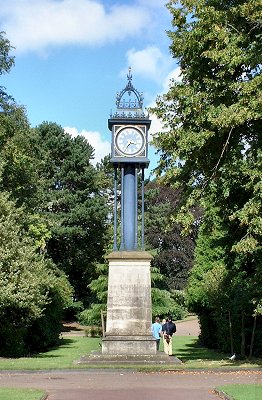 |
The clock tower has recently been restored and the cast iron
upper part nicely painted.
The clock was given by Councillor John Ross
in 1883.
He was a Scot by origin, which probably explains why the
finials on the clock are in the form of thistles. |
The Pavilion north of the Lake:
| Unofficially known as the Duck Shelter. It stands on
the side of the lake, which contains a large and varied collection of
waterfowl. It makes a fascinating feature - in what one might call the
Carpenter's Decorated style - with echoes of dovecotes and railway platform
canopies. |
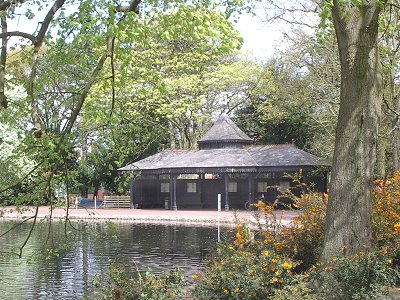 |
The Erratic Boulder:
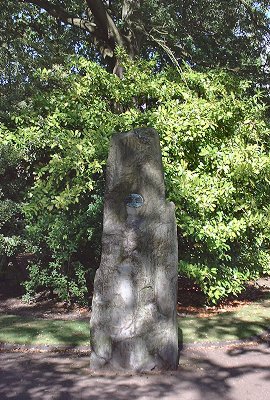 |
There is another erratic in the park but this is the first
and biggest. Its presence typifies Victorian enthusiasm for geology,
curiosities and educating the working classes. The metal plaque on it
reads: "Block of Felsite, carried during the glacial epoch from
Arenic, Merionethshire. Found in Oak St. Wolverhampton in 1881".
In the garden of Wightwick Manor there is a whole array of local erratics,
further testifying to Victorian interest in geology. |
|
The North Lodge. |
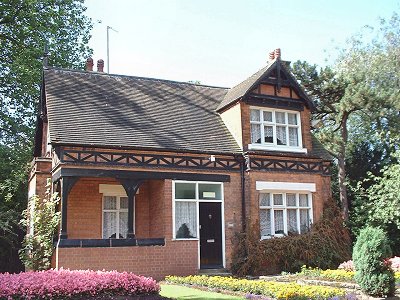 |
 |
The South Lodge. |
The Builder, in its issue of 11th June 1881, notes
the opening of the park by the Mayor on Whit Monday 1881 and that the 50
acres of land was leased from the Duke of Cleveland for £300 per annum for
42 years then at £350 for the following 21 years, with an option to purchase
for £20,000 at the end of the lease. [This option was taken up].
It also notes that R. H. Vertegens, of Chad Valley Nurseries, Birmingham,
won the competition for the best design and got a prize of £50.
They then describe the two lodges which are "built of
pressed red bricks, from the Adderley Park Company, at Birmingham, with
stone dressings from the Darley Dale quarries, Derbyshire, the style being
Old English with partially timbered gables. They contain, on the
ground floor, two living rooms (each having a window overlooking the
entrance gates), kitchen and scullery; and upstairs there are two good
rooms. Behind each lodge there is a small yard containing the
necessary outhouses, and the coping wall of the wall enclosing the yard is
broken and embattled to be in keeping with the lodge. The whole of the
structural works have been carried out under the supervision and from the
designs of Mr. G. Eastlake Thomas, C.E., the borough engineer. Messrs.
Bradney & Co have been the contractors for the lodge, shelters, &c; Messrs.
P. Horsman & Co. the contractors for the masonry work of the boundary fence;
and Messrs. Bayliss, Jones & Bayliss have constructed the iron palisades and
ornamental gates".
|
The South Shelter. |
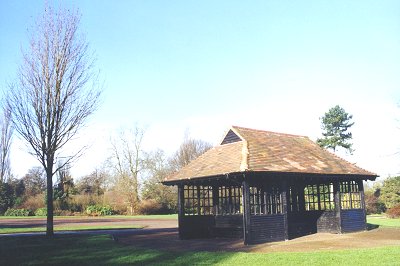 |
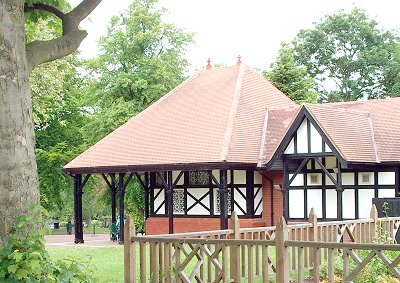 |
The Chalet. |
This was originally the Refreshment Pavilion and was
opened in 1901. Later it was known as the Chalet. It had
not been used as tea rooms since about 1990 but it was used as a
facility by visiting school groups and others. In 2002 work
started to restore it as a tea room and educational centre.
The new tea rooms opened in May 2005, providing not just ice cream
and pop, but tea, coffee, cakes and snacks. The front room
retains many of the original tiles and those that were missing have
been copied and replaced. The result is the best tiled room in
the city. There is also another room at the back with a
terrace and fenced garden and lawn. The terrace under the portico at
the front gives views of the bandstand and lake.
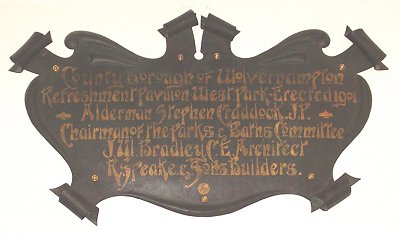
High on the wall inside the front room is this
plaque, which commemorates the opening of the building. It
reads: "County Borough of Wolverhampton / Refreshment Pavilion
West Park - Erected 1901 / Alderman Stephen Craddock JP / Chairman
of the Parks and Baths Committee / J. W. Bradley. C.E. Architect /
R. Speake & Sons. Builders." It seems to be made out of
japanned and gilded tinplate and was, presumably, made by a local
firm. If all that it is right it is a very interesting example
of local japanned ware. According to contemporary editions of
the Wolverhampton Red Book the "tea chalet" cost £750.
Alderman Stephen Craddock was a long serving member
of the council and owned Craddock Bros. Ltd., who claimed to be the
largest boot manufacturer in the Midlands.
Statue of Charles Villiers:
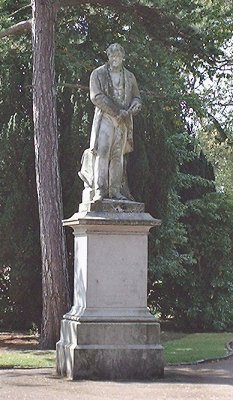 |
The inscription on the front says: "Charles
Pelham Villiers, PC, MP, Born 3rd January 1802, died 16th
January 1898, aged 92 years". The inscription on
the back says: "This statue was erected by public
subscription in recognition of the eminent services rendered
by Mr.Villiers to his country, especially in connection with
the repeal of the corn laws.
He represented the
Parliamentary Borough of Wolverhampton in the House of
Commons from 1835 until the division of the Borough in 1885,
when he was returned for the South Division, which he
represented until his death."
This statue originally littered up the roadway in the
city centre outside the central library. It was moved
to allow for road improvements. The story is that when
the local sculptor, Sir Charles Wheeler, was asked where it
should be moved to, he said: "To West Park - preferably
behind a large bush". |
More prosaically, Noszlopy and Waterhouse say "His donation of a
bandstand to the park in 1882 may have influenced the decision to
move the statue there in 1931". They also say the statue is of
marble and that he is in the pose of a public speaker, with his
notes in his hand; and that his cloak is draped over a pillar behind
him. This, they say, is reminiscent of Matthew Noble's statue
of Robert Peel in Parliament Square, which was executed in 1876.
They say that this gives the work associations with the classical
world and its political values.
| Villiers' term in Parliament remains the
national record for long service there; but there is
also a story that in all the time he represented
Wolverhampton, he never visited the place. He did not
turn up to the opening of West Park - but sent the bandstand
instead. Others say that he only absented
himself for the last 20 years of his career. His
popularity seems to have been based on his support for the
repeal of the Corn Laws.
This drawing of him (left) seems to show him in his
younger days. |
 |
Walls, gates and railings

The main south gate. The gates, piers and
walls are modest and rather restrained for the time - perhaps the
style is Financially Prudent, rather that Civic Ostentation.
All the railings were originally made by the local firm of Bayliss
Jones and Bayliss, who were often called on to do bigger, more
elaborate and imposing work than this. But there are sections
with other names on them, some of which may mark the removal of the
originals to hold one of the big shows which have occasionally used
the park.

|